The Golden Dishes menu of team 52, Cam Thanh restaurant, was led by famous Ly Son specialties. Priceless gifts from the oceans, as the chefs called, really wowed the jury and audiences.
“Ly Son seafood – priceless gifts from the
oceans” was the
topic of The Golden Dishes that Quang Ngai chefs brought to the semi-final
round of The Golden Spoon 2016. As its name, the menu was filled with all
regional specialties from Ly Son Island, such as Pacific oysters, sea
cucumbers, seaweed, and black garlic. Moreover, local products were classically
enriched by imported classy food like beef tenderloin from the US, French foie
gras, and truffle mushroom.

Chef Nguyen Minh Hien was trimming shells of the slipper lobster.
In
the presentation, chef Nguyen Minh Hien was really confident saying about his
chance to go to the final round, “90% expectation”. In fact, that was the
target that his whole team had set after winning the 1st prize of Middle
Southern preliminary. They were so much proud of being the very first
representation of Quang Ngai province coming to The Golden Spoon’s final round.
The
chefs of Quang Ngai province had well prepared for the away competition. Chef
Minh Hien said that right after the preliminary, they started discussing and
planning for next round even though every one was quite busy at work. Being
confident and passionate with homeland cuisine but they also realized that
great food need highlights. They need to maintain original flavors while apply
new cooking methods to match progressive culinary trends.
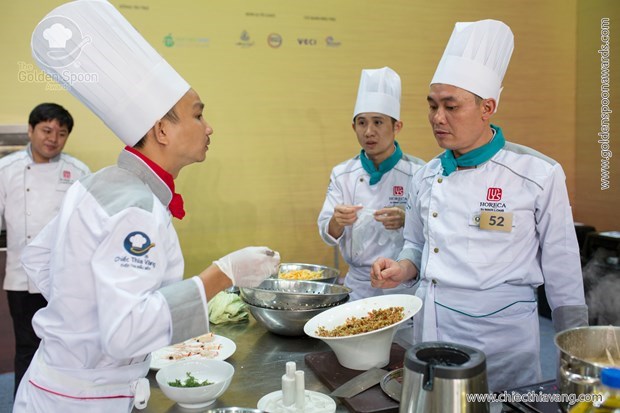
3 chefs of Cam Thanh hotels were discussing in their kiosk at The Golden Spoon contest 2016.
“We did only time
trial for the dish because we had been discussing and dividing specific tasks
for each member. We also expected some difficulties, in which the biggest
problem was our transporting. We’ve been travelled quite far, and temperature
changes also effect ingredients’ freshness”, said chef Minh Hien. Seeing uploading photos on
Facebook, people realized how hard for 3 chefs of Quang Ngai to keep their
regional ingredients as their best condition.
In
fact, their hard work had paid off. Judge Ly Sanh commented, “Delicious and tasty. Another point is
decoration, very logical and well blended to cheer diners up. I am surprised
when they kept Ly Son seafood as that fresh. Besides, the way they handle black
garlic is excellent. They eliminated unpleasant bitterness of garlic and turned
them to delicious and exotic dish.”
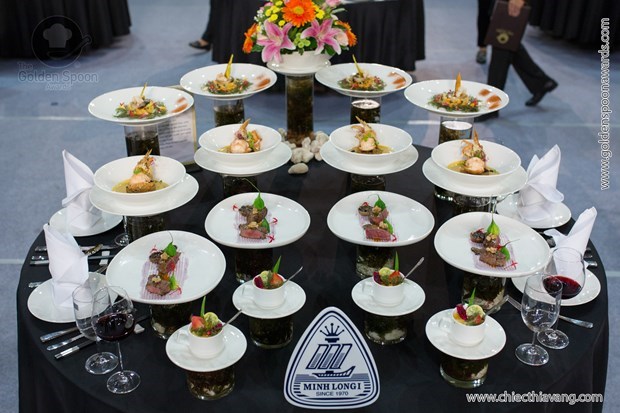
Display table of The Golden Dishes – team 52 – Northern semi-final round.
In
this round, the Golden Dishes of team 52 included 1) Ly Son Pacific oyster
salad served with New Zealand lobster and Ly Son sea cucumber; 2) Primitively
steamed Ly Son slipper lobster in Ly Son black garlic wine broth, served with
New Zealand lobster’s head, Couscous seeds, and Sung leaves; 3) Sautéed beef
tenderloin in Truffle mushroom sauce and French foie gras served with Lang
Huyet root; 4) French style cream caramel served with pandan marinated Ly Son seaweed.
According
to chef Minh Hien, they had exploited the crunchy yet chewy texture of Pacific
oysters and traditional salad dressing in the appetizer. Moroever, sweet and
tender New Zealand lobsters diversified the salad, making it more modern but
the original flavor still remained. Chef Minh Hien informed that sea cucumbers
in Ly Son were rare seafood and very nutritious while the Pacific oysters were
strange looking. They look like pipes made from limestone so local people
called them “pipe oysters”.
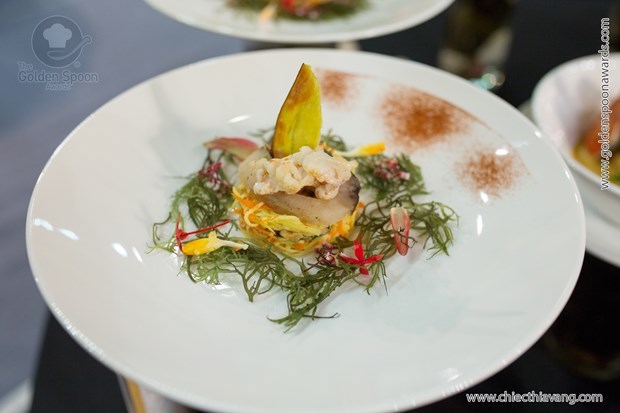
Ly Son pipe oysters’ salad served with New Zealand lobster and Ly Son sea cucumbers.
Chef
Minh Hien shared his story about how hard to catch this type of oysters.
Fishermen have to dive 15 – 20m in areas of fossil corals but they do need
experiences and expertise skills. Otherwise, they just collect only limestone
shells while oysters’ flesh still clings on fossil corals. Besides Ly Son, pipe
oysters have also found in Binh Thuan and Khanh Hoa areas. To catch them is
hard; to prepare them is not any easier. If you make it wrong, the flesh will
be crushed and torn apart. Therefore, right after choosing pipe oysters as main
ingredients, chef Minh Hien had met some old men of Ly Son to learn how to
prepare and process them, both raw and cooked.
Pipe
oysters were rare boiled, skillfully sundered the mussel, and gutted out.
Oyster flesh would be cleaned by salt and lime juice then soaked in ice for 15
minutes to reduce fishy smell. Next, oyster flesh would be boiled in coconut
juice with lemongrass and chili. After cooked, the flesh once again was soaked
in ice and lime juice to maintain their texture. Finally, the whole oyster
flesh, sliced sea cucumbers, and New Zealand lobsters would be mixed with
carrot, mangoes, and seaweed.
The
next course included primitively steamed Ly Son slipper lobsters served with Ly
Son black garlic wine broth and New Zealand lobster’s head served with Couscous
seeds and Sung leaves (Zanthoxylum
nitidum Roxb), which were two main dishes of the golden menu. Red slipper
lobsters are Ly Son specialties with smooth sweetness and firm texture. The
broth was cooked from New Zealand lobsters’ heads and black garlic wine while
side dishes included couscous seeds and some kinds of vegetables with
outstanding Sung leaves. Lead chef of team 52 informed, “We chose primitive cooking method, just to boil both types of lobsters
so that the transparent taste of New Zealand lobsters would back the smooth
taste of red slipper lobster up.”
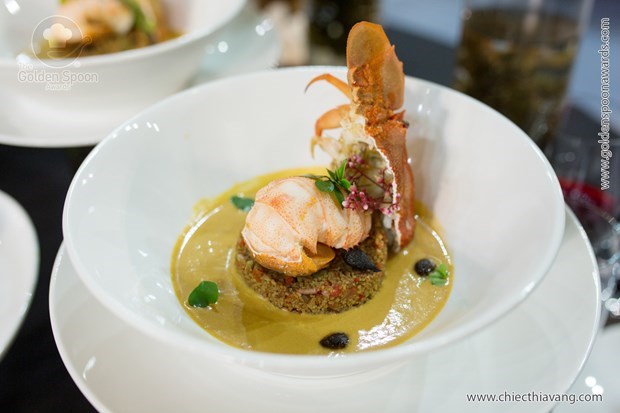
Primitively steamed Ly Son slipper lobster in Ly Son black garlic wine broth, served with New Zealand lobster’s head, Couscous seeds, and Sung leaves.
In
the course, New Zealand lobsters’ heads were stir-fried with carrots, celeries,
bell peppers, and scallion. The whole stir-fried food then would be grinded
with cream and a tablespoon of black garlic wine and filtered to get the broth.
“Black garlic wine has a bit bitter taste
so only a tablespoon should be enough”, said chef Minh Hien. Couscous was
an essential element to balance starch and meat in the dish. Couscous look like
grains but actually it’s a type of pasta, which is very popular from Africa
(Morocco, Tunisia, Libya, Algeria, Egypt), the Middle East to Europe (France,
Spain, and Greece). People usually steam couscous, or cook as rice with salt
and butter to taste.
Instead
of using rosemary and basil as people usually do in some countries, our chefs
picked Sung leaves, a popular spicy tree in the Middle of Viet Nam. Tips of
Sung trees have strong and aromatic essence and mint-like after-taste. Cooked
couscous would be shaped into a pedestal, where to place steamed red slipper
lobster and poured the broth onto.

Sautéed beef tenderloin in Truffle mushroom sauce and French foie gras served with Lang Huyet root.
The
main course, Sautéed beef tenderloin in Truffle mushroom sauce and French gras
foie served with Lang Huyet root, was made from imported ingredients but the
vital spices were Quang Ngai featured. Chef Minh Hien said, “The impression of the dish is about spices.
Instead of black peppers, we used lemongrass fruits to make it unique. Side
dishes were mashed Lang Huyet roots and truffle mushroom to provide enough
starch and to make it luxury. Moreover, the sauce was also added French foie
gras for delicately fatty taste.” Lemongrass fruits used to appear in
Fillet Nien fish rolled lemongrass fruits in one of the preliminaries. This is
a type of spicy fruits from wild trees in Ba To mountain area, which has strong
oil and lemongrass-like aroma. Local people usually marinate fish or meat by
these interesting fruits before steaming or grilling. In this main course, beef
tenderloin was bite-size chopped, marinated with spices and lemongrass fruits
then sautéed whereas the sauce was made from 2 classy ingredients, French foie
gras and truffle mushroom.

French style cream caramel served with pandan marinated Ly Son seaweed.
The
dessert - French style cream caramel served with pandan marinated Ly Son
seaweed – was inspired by French culinary method but our chefs wanted to bring
Ly Son features into the dish, which was fresh seaweed. Briefly, beat fresh
cream and eggs then add fresh pandan leaf juice, vanilla, and blanched fresh
seaweed; steam the whole mixture until cooked. To emphasize homeland flavors,
the team brought Dan oranges into their dessert. Dan oranges are small size and
seedy but their flavor is impressively sweet.
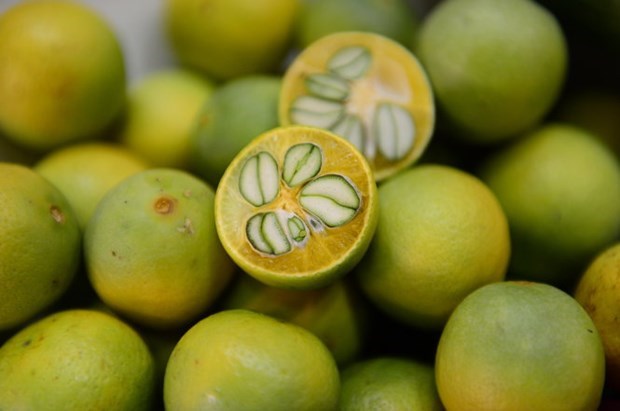
Cam Dan (Dan oranges).
To
vary Ly Son endemic specialties and to elevate the menu by exotic classy
ingredients did help team 52 to win a ticket to the final round. It was an
impressive achievement because this was the first time ever they had been in
The Golden Spoon contest but they immediately became of the top 15. The chance
to win 1 billion vnd and The Golden Spoon championship would not be to far from
their skillful hands.
By Nguyen Trang